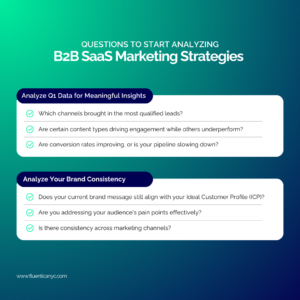Rethink Your Q2 Plan: B2B SaaS Marketing Strategies Aren’t About Quick Fixes
B2B SaaS marketing strategies take time to generate results. With Q2 around the corner, it’s tempting to make drastic changes based on short-term data. But before shifting direction, take a step back. In B2B SaaS, sales cycles are long—often spanning months—while campaign planning operates on a much shorter timeline.
For B2B SaaS companies, especially startups still in the awareness phase, changing everything in Q2 can do more harm than good. Instead of chasing quick fixes, focus on refining what’s working and staying consistent with your brand message. A sudden pivot can erase the momentum you’ve built and make it harder to measure success in later quarters.
Why Drastic Changes in Q2 Can Backfire
Startups often expect immediate results from early marketing efforts. But in reality, most B2B SaaS sales cycles could go between a few weeks to three or six months, and sometimes longer. Making major changes based on Q1 results could mean abandoning strategies that haven’t had enough time to deliver outcomes.
Short Campaign Cycles vs. Long Sales Cycles
- Marketing campaigns typically run for 3-6 months before showing meaningful data.
- Sales cycles in B2B SaaS extend across multiple quarters, often requiring multiple touchpoints before conversion.
- Drastic changes too soon can disrupt existing efforts and create inconsistency in messaging, confusing potential customers still in the decision-making process.
Instead of reacting impulsively, use Q2 as a checkpoint to optimize what’s working while maintaining strategic consistency.
How to Adjust Your B2B SaaS Marketing Strategies Without Losing Momentum
A strong Q2 strategy isn’t about doing more—it’s about doing better. Here’s how to make adjustments without stalling your growth.

Analyze Q1 Data for Meaningful Insights
Before making any shifts, take a deep dive into Q1 reports:
- Which channels brought in the most qualified leads?
- Are certain content types driving engagement while others underperform?
- Are conversion rates improving, or is your pipeline slowing down?
Looking at these numbers in isolation won’t tell the full story. Compare them against your B2B SaaS sales cycle timeline to understand whether your campaigns need optimization or more time to mature.
Stay Loyal to Your Brand Message
Brand inconsistency can be one of the biggest pitfalls of reactive marketing. If your core messaging keeps shifting, prospects won’t know what your company stands for. Ask yourself:
- Does your current brand message still align with your Ideal Customer Profile (ICP)?
- Are you addressing your audience’s pain points effectively?
- Is there consistency across marketing channels?
Instead of reinventing your messaging in Q2, refine it to reinforce your positioning.
Focus on Optimization Instead of Overhaul
Rather than shutting down underperforming campaigns, fine-tune them:
- Adjust audience targeting for paid ads instead of cutting ad spending entirely.
- Repurpose high-performing content into new formats (e.g., blog posts into LinkedIn carousels).
- Improve email sequences by A/B testing subject lines or CTAs.
These refinements allow you to improve results without resetting the foundation of your B2B SaaS marketing strategies.
What Startups Should Do to Stay on Track in Q2
To make sure your marketing strategies remain effective, focus on measurable improvements rather than sweeping changes.
- Record Your Q1 Results for Benchmarking
Your Q1 data serves as a baseline. Instead of comparing individual campaigns in isolation, track trends over time to spot gradual improvements or red flags. - Keep Nurturing Leads Already in Your Pipeline
B2B SaaS sales cycles require ongoing engagement. Many prospects who entered your funnel in Q1 won’t convert until Q3 or Q4. Keep nurturing them with valuable content and relevant touchpoints instead of prematurely shifting focus. - Strengthen High-Performing Channels
Rather than trying to be everywhere, double down on what’s already working. If organic LinkedIn posts are consistently driving engagement, expand that effort instead of spreading resources thinly across multiple underperforming platforms. - Plan for Q3 Without Overcommitting
Start forecasting for Q3 now, but avoid locking yourself into rigid plans. Flexibility is essential, but so is consistency.
Growth B2B Marketing Growth Takes Time
B2B SaaS marketing isn’t about immediate wins, it’s about building momentum that pays off over time. Changing everything in Q2 just because Q1 didn’t deliver instant results could erase the progress you’ve already made. Instead of chasing quick fixes, focus on refining what works, staying true to your brand message, and aligning your marketing efforts with your sales cycle.
Your strategy should be dynamic but not reactionary. Sales cycles take time, and your Q1 efforts may not show full results until later in the year. Keep tracking performance, optimizing where necessary, and maintaining consistency. The strongest brands don’t pivot every quarter—they evolve strategically.
By making thoughtful adjustments instead of drastic changes, your Q2 strategy will set the foundation for sustainable growth, stronger customer relationships, and long-term success.
Keeping it Fluent with this
Quick Q&A
Regular optimizations are essential, but drastic changes every quarter can hurt momentum. Adjust tactically, not impulsively.
Don’t panic. B2B SaaS sales cycles are long. Look for trends, refine targeting, and stay consistent with your core messaging before making major changes.
Treat marketing as a long-term investment. Campaigns may run in 3-6 month cycles, but sales often take longer. Keep nurturing leads and building awareness.
Only if your data suggests a misalignment. If engagement is slow but improving, optimize rather than completely change your approach.
Amy Perez
From grassroots and housing non-profit organizations to the B2B tech world and even a sprinkle of B2C law, Amy's experience runs the gamut. She excels at establishing and shaping brands from the ground up, setting the stage for success. That's why she co-founded Fluentica—to support the next generation of brands ready to make waves.
Related Posts
- B2B marketing
- Brand Strategy
- Branding
- Content Strategy
- Digital Marketing
- Fluentica
- Intercultural Marketing Strategies
- Marketing
- Marketing Strategy
- Multicultural Marketing Trends
- Paid Advertising
- SEO Strategy
- Sin categorizar
- Small Business Marketing
- SMB Marketing
- Social Media Strategy
- Startup Marketing
- US Hispanic Market Insights
- Websites








